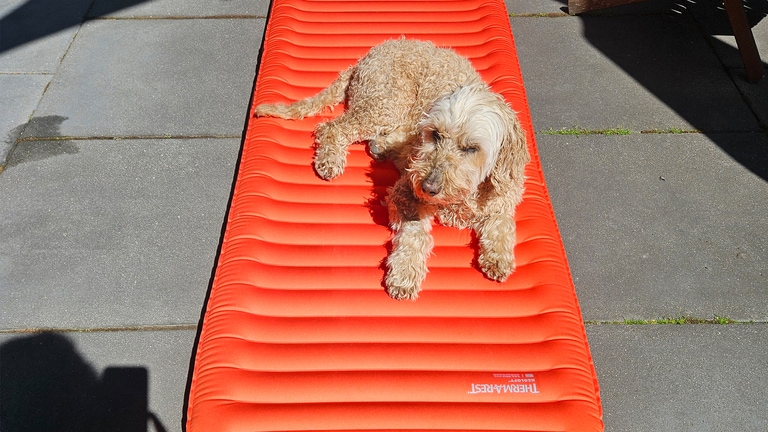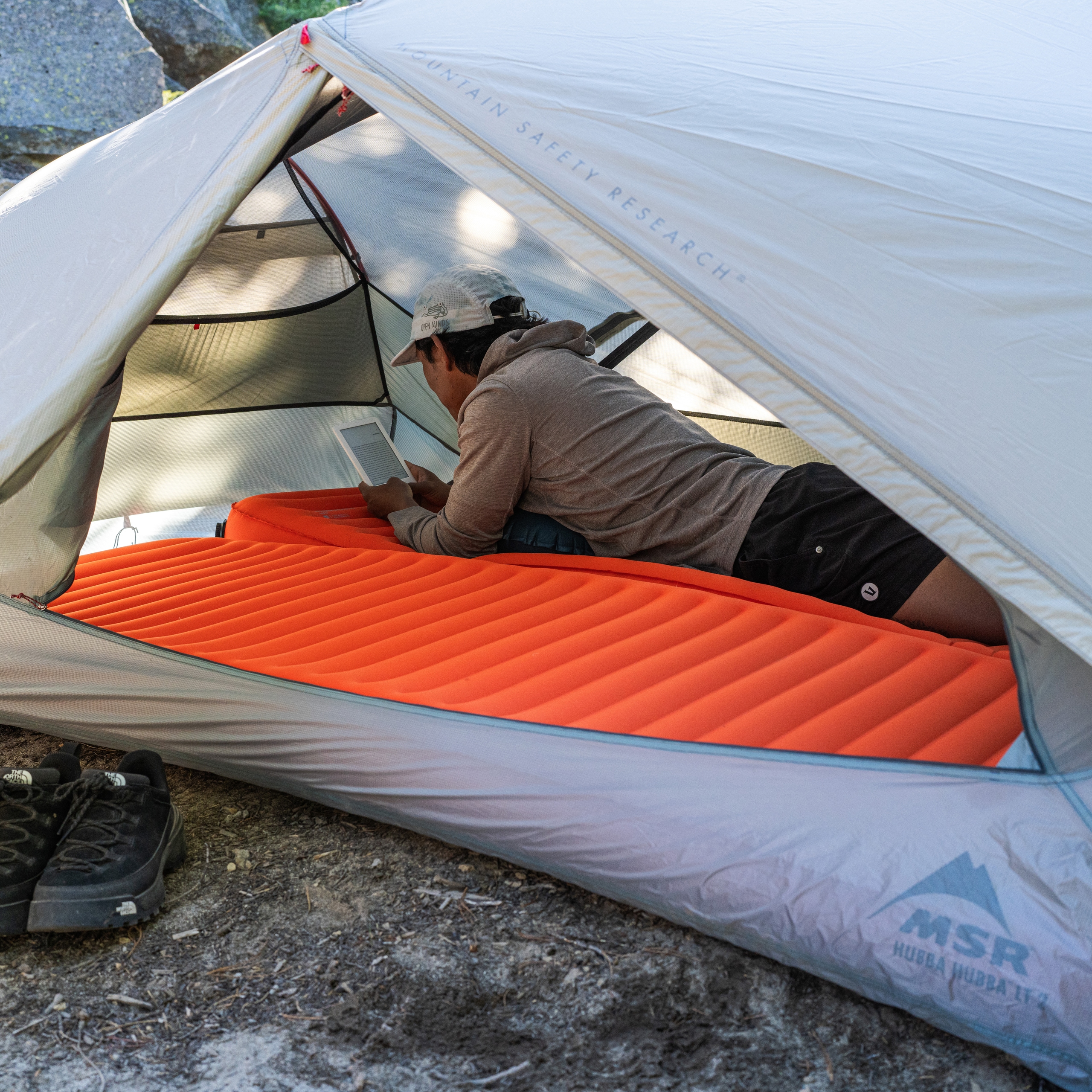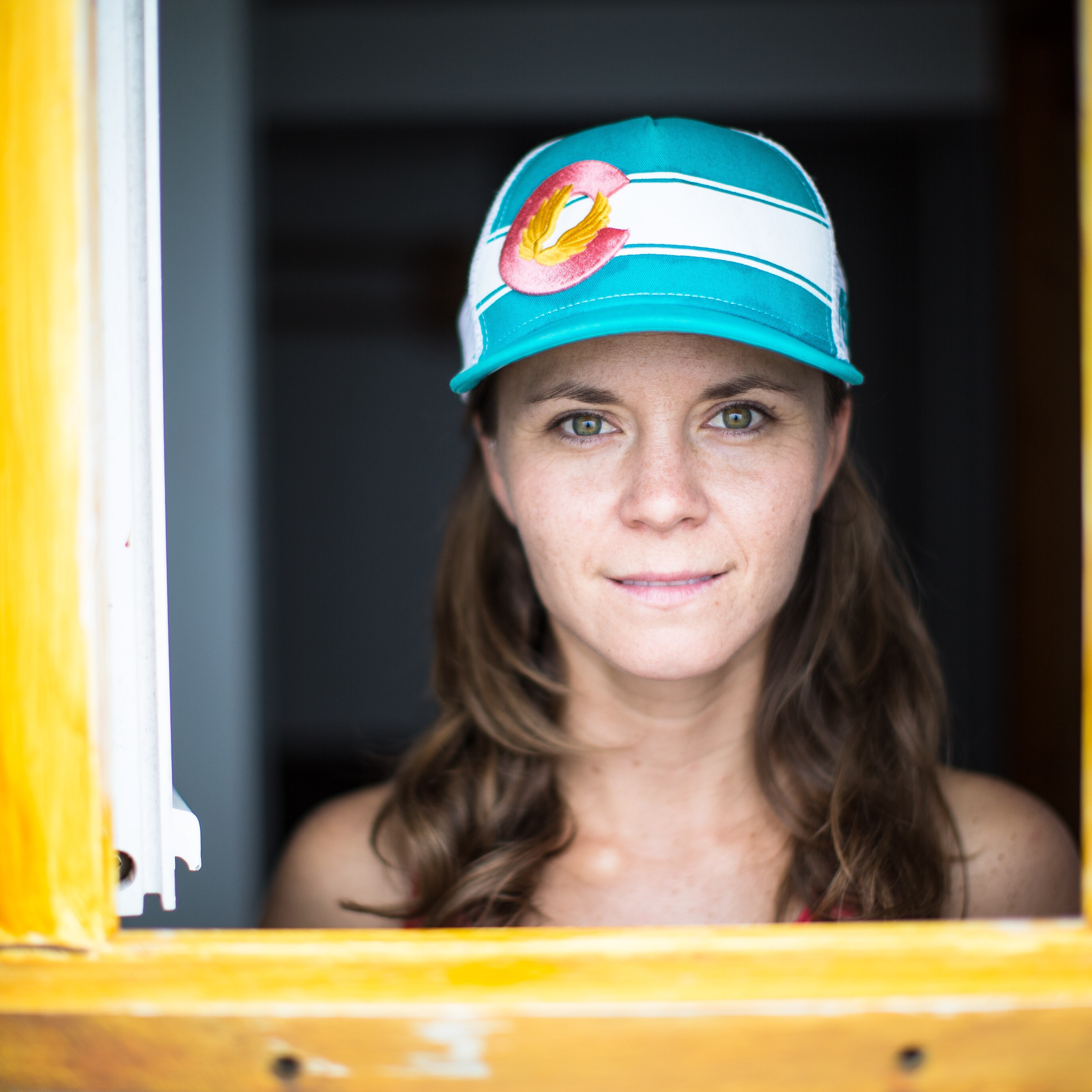Backpacking often means ultralight, but that doesn't mean it should feel ultracramped. Thankfully, our favorite outdoor brands are finally realizing campers come in all shapes and sizes—and so should gear. What does that mean for you? More space to sprawl. "Standard" sleeping pads traditionally measure 20 inches wide and 72 inches long. But each backpacking pad on this list hits 24 inches wide, and almost all of them boast extended length options, some running 78 inches long.
We know it’s difficult to sift through the numbers, so we did that for you. We worked with member-testers ranging in all sizes, from large to 4XL to take out a bevy of wide and long backpacking pads offered at REI. Our crew spent months sleeping under the stars and rolling through the dirt, all in an effort to bring you the best wide sleeping pads.
The 5 Best Wide Sleeping Pads of 2025: Tested
Find our quick recommendations here or read on for the full breakdown of our field test of the best wide sleeping pads.
- NEMO Quasar 3D Insulated Air Sleeping Pad — Editors' Choice Award Winner
- Therma-a-Rest NeoLoft Sleeping Pad
- Big Agnes Rapide SL Insulated Sleeping Pad
- NEMO Flyer Self-Inflating Sleeping Pad
- REI Co-op AirRail Plus Sleeping Pad
Editors' note: We updated this gear guide on June 25, 2025, to replace out-of-stock products and include the Therm-a-Rest NeoLoft.

NEMO Quasar 3D Insulated Air Sleeping Pad
Score 94
Pad type Air
Versions Regular, Regular Wide and Long Wide
Insulation Synthetic
R-Value 3.3
Weight 1 lb. 14 oz. (Regular Wide)
Dimensions 72 x 20 x 3.5 inches (Regular), 72 x 25 x 3.5 inches (Regular Wide), 76 x 25 x 3.5 inches (Long Wide)
Pad thickness 3.5 inches
Since 74% of the population sleeps on their sides, we're willing to bet at least 74% of our readers are stoked to find the Quasar 3D. But a number of smart details add up to utter comfiness for sleepers of all kinds.
To fix a common complaint for those who don't sleep stock-still on their backs, NEMO created a body-mapped depression in the center of the 25-inch-wide pad that prevents campers from rolling off in the middle of the night. The built-in pillow at the top of the pad helps sleepers rest easy as their limbs and hips relax just like at home. Add in the 3.5-inch thickness—by far the cushiest in test—and our testing crew found themselves in dreamland. "My hips never once hit the ground," reports one Wisconsin tester. "Honestly, the Quasar is so comfy that I've been using it for naps on my living room floor." Yes, you read that right: It's replacing her mattress at home.
The plush-and-lush 30-denier polyester stretches over the top, adding sheetlike coziness to this rectangular pad. Synthetic insulation up-levels the warmth, making the Quasar a toasty pick for the worst of three-season conditions. Even with all these features, the pad still rolls up (stuff sack included) to the height of 1.5 Nalgene bottles. "I try to keep my pack weight at 12 to 18 pounds, but I'll still make this pad a priority," one tester reports after a trip to Wisconsin's Northern Highland American Legion State Forest. One tester proclaimed it "luxuriously thick" after camping in Leavenworth, Washington. "The pad itself is just wide enough and easy for me to toss and turn on," she adds. Bonus: The entire backpacking pad is made from 100% postconsumer recycled materials.
Bottom Line: Backpackers wanting unmatched comfort (no matter how they sleep) and respectable packability should reach for the plush NEMO Quasar 3D Insulated Air Sleeping Pad.
Testing Stats:
- Nights out: 22
- Testing states: Minnesota, Wisconsin
Therm-a-Rest NeoLoft Sleeping Pad
Score 91
Pad type Air
Versions Regular, Regular wide, Large
Insulation None
R-Value 4.7
Weight 1 lb. 8.9 oz. (regular), 1 lb. 14 oz. (regular wide), 2 lbs. (large)
Dimensions 73 x 22 x 4.6 in. (regular), 73 x 26 x 4.6 in. (regular wide), 78 x 26 x 4.6 in. (large)
Pad thickness 4.6 in.
Best for Backpacking, car camping, restless sleepers, comfort
Roomily rectangular and thick enough to resemble a mattress, the Therm-a-Rest NeoLoft Sleeping Pad doesn’t look like it’s meant to be schlepped into the backcountry. Close your eyes and you wouldn’t believe you’re sleeping on a backpacking-friendly pad, either. (Especially once you’ve opened your eyes many hours later, well rested.) Our backpack editor struggles with chronic pain and insomnia but proclaimed: “This sleeping pad is among the coziest I've ever slept on. I'm not being hyperbolic when I say I had the best night's sleep while camping with this.”
Testers uniformly praised the NeoLoft’s cush factor, providing such thorough protection from the ground that our tester, who took it on a backpacking trip in Old Logger's Path in Pennsylvania, compared it to sleeping on a cloud. (This was also a plus for side sleepers, who found that their hips didn’t hit the ground like with thinner pads.) They also liked the velvety, stretchy knit fabric covering the pad, and the stability offered by its broad surface and slightly sloped edges—no risk of accidentally falling overboard here.
“I own several Therm-a-Rest air sleeping pads because I love how light they are while still providing warmth,” said one Washington-based tester. “The NeoLoft is by far the plushiest, most comfortable and quietest of them.” The tradeoff? A pad that brings this much coziness is going to take up a bit of room. You’ll probably squish your tent-mate if you and your NeoLoft share a two-person shelter with them. And it’s on the heavier side for a backpacking pad, weighing up to 2 pounds for the largest size. Still, it’s fairly compact in its included stuff sack—around the size of a Nalgene bottle—and all testers said they would happily swap lighter pads for the comfort of the NeoLoft in most cases. Buy here.
Bottom Line: Ultimate comfort and stability for restless, achy sleepers, in a just-light-enough package to make the cut for backpackers who’d rather catch quality z’s than ultralight cred.
Testing Stats:
- Nights out: 10
- Testing states: California, Pennsylvania, Washington
- Best testing stories: "The pad was 4.5 inches thick and it felt like I was sleeping on a cloud," says our Pennsylvania-based tester. "I wish I had a fun or interesting story about my experience with the pad, but I slept through the night with no problems. Boring is good, right?!" Our Washington-based tester adds: "My dog loves this mat!"

Big Agnes Rapide SL Insulated Sleeping Pad
Score 93
Pad type Air
Versions Petite, Regular, Regular Wide, Long, Long Wide and Double Wide
Insulation Synthetic
R-value 4.8
Weight 1 lb. 7 oz. (Regular Wide)
Dimensions 66 x 20 x 4.25 inches (Petitie), 72 x 20 x 4.25 inches (Regular), 72 x 25 x 4.25 inches (Regular Wide), 78 x 20 x 4.25 inches (Long), 78 x 25 x 4.25 inches (Long Wide)
Pad thickness 4.25 inches
It takes a lot to impress us, but the Big Agnes Rapide SL Insulated pad checks all the boxes for backpackers who want to lighten their load while taking long walks through nature. For starters, it’s about as warm as a sleeping pad can get without being categorized as a winter product. Thanks to two layers of heat-reflective film inside the pad, the Rapide has an R-value of 4.8 (cold-weather pads start around 4 and extreme-cold-weather pads start at 5.5) and it sleeps that way. One tester ventured to Southern Utah to explore canyon country in mid November, and she was pleasantly surprised to wake up warm after overnight lows of roughly 40°F.
Comfort is still a priority, thanks to the whopping 3.5 inches of padding and 4.25-inch-thick side chambers. The center is cushy enough that you can roll around without your joints digging into the ground, and the plush side chambers cradle you like a pseudo-bassinet. (Note: The Rapide doesn’t have specific side rails like the REI Co-op AirRail does, but the substantial side chambers do helpcenter your body on the pad).
The best part: All this warmth and coziness comes with only a small weight penalty. The regular wide version clocks in at 1 pound, 7 ounces and rolls up to be smaller than your water bottle.
Bottom Line: If you’re a backpacker who wants it all in a sleeping pad—light, packable, überwarm and wide—you can do no better than the Big Agnes Rapide SL insulated sleeping pad.
Testing Stats:
- Nights out: 14
- Testing states: California, Utah
- Best testing anecdote: “There is nothing more magical than cowboy camping under the stars,” says our tester after his trip to Utah’s Canyon Country. “I threw my pad onto the sandstone, let the frost settle onto my sleeping bag and watched the twinkling in the night sky above.”
NEMO Flyer Self-Inflating Sleeping Pad
Score 92
Pad type Self-inflating
Versions Regular, Regular Wide and Long Wide
Insulation Open-cell foam
R-value 3.3
Weight 1 lb. 10 oz. (Regular Wide)
Dimensions 72 x 20 x 2 inches (Regular), 72 x 25 x 2 inches (Regular Wide), 76 x 25 x 2 inches (Long Wide)
Pad thickness 2 inches
Fossil fuels are hard to quit, but seeking out recycled materials are a good start. Many sleeping bags' outer fabric is polyester—a petroleum-derived material. In an effort to reduce their reliance on the fossil fuel industry and cut back on waste and greenhouse gas emissions from manufacturing, the team at NEMO uses 100% recycled polyester for this pad's shell and stuff sack, reducing the need to tap into new polyester manufacturing. And the Flyer is the first bluesign®-certified NEMO product, which means the pad has been crafted with strict safety and environmental guidelines.
It performs well too. NEMO slashed 60% of the foam (compared with traditional self-inflating foam pad manufacturing) to cut weight, using air and horizontal foam chambers to create a cozy pad with 2-inch of thickness. “I could even sleep on my side without my hips hitting the ground,” reports one Utah-based tester. It’s reasonably light—though certainly not ultralight—and packs down to roughly the size of two Nalgene bottles.
Be prepared for slow inflation time, according to some member-testers. Others report that the Flyer never seems to fully inflate on its own, so you may need to top it off with a few breaths.
Bottom Line: Recycled materials and bluesign® certification make the NEMO Flyer a more sustainable choice for a wide sleeping pad that works well in the back or frontcountry.
Testing Stats:
- Nights out: 11
- Testing states: Colorado, Utah
- Best testing anecdote:: One tester brought the Flyer along on an overnight bikepacking trip and awoke to find cows outside her tent. “I was cozied up on my pad when I heard some weird shuffling outside,” she says. “I threw back the tent flap to see a dozen big eyes and large heads staring back at me.”
REI Co-op AirRail Plus Sleeping Pad
Score 91
Pad type Self-inflating
Versions Short, Regular and Long
Insulation Open-cell foam
R-value 4.2
Weight:: 1 lb. 14 oz. (Long)
Dimensions 66 x 24 x 1.5 inches (Short), 73 x 24 x 1.5 inches (Regular), 78 x 24 x 1.5 inches (Long)
Pad thickness 1.5 inches
For campers with large bodies (as well as those who wiggle around a lot), simply staying on the pad all night can be a challenge. Luckily, it’s a problem easily remedied by the REI Co-op AirRail Plus. Inflatable rails along the side and top of the pad add a little buffer that gently keeps you on the pad while creating a cozy, nestled environment. “[The rails were] almost like having a little cuddle pillow,” says our New Hampshire tester after a weekend trip in the White Mountains. Tradeoff: The side rails don’t inflate separately from the 1.5-inch-thick pad, so a firmer pad means firmer side rails and a softer pad means floppier rails.
The pad's top and bottom are made from 75-denier polyester, which is quite rugged for a sleeping pad. Testers didn’t have any durability issues in testing, and they never used a groundcover beneath the tent. You can use the AirRail any time outside of winter thanks to its R-value of 4.2, and it makes a great pick for high-country camping when summer nights still get a bit breezy. As an added bonus, the AirRail is one of the more affordable picks on this list—and the price doesn’t increase if you need the long version.
Caveat: Like the NEMO Flyer, the self-inflation time is very slow. Testers never could get the AirRail to fully inflate on its own, so plan on using your own hot air to fill ’er up.
Bottom Line: Strategically placed sidewalls and durable materials make the REI Co-op AirRail Plus a top pick for car camping weekends when comfort and ruggedness trump packability.
Testing Stats:
- Nights out: 9
- Testing states: New Hampshire
- Best testing anecdote: “My kid thought the side walls were the coolest thing ever,” says our New Hampshire tester after bringing her son along for the weekend. “On the second night, I lost my pad to the overbearing kindergartener.”
Buying Advice
Here’s a little-known fact: Your sleeping pad is just as important as a sleeping bag when it comes to keeping you warm at camp. That's because it helps insulate you from the cold ground, allowing you to maintain more of your body heat. We know it can feel confusing to wade through all the tech specs and industry jargon, so here are a few factors to consider when nabbing yourself a wide sleeping pad for backpacking.
Types of Pads
You have three main sleeping-pad styles to choose from: air pads, self-inflating foam pads and closed-cell foam pads.
Backpacking pads can be found in all three categories, but you’re most likely to see air pads. These types of pads are comfortable and can be more packable. They don’t self-inflate, but they often come with a pump sack or inflation bag since using our lungs takes a bit of work! The air inflation makes it easier and often quicker to inflate than the self-inflating pads, but it does mean they tend to soften in cooler temperatures.
The wide air pads in this guide are the NEMO Quasar 3D Insulated, Big Agnes Rapide SL and Therma-a-Rest NeoLoft Sleeping Pad sleeping pads.
Self-inflating pads take less personalized work to inflate than air pads: Open the inflation valve and watch the magic happen. This will typically take around five minutes and may require a manual top-off with your mouth on the valve to get the pad to perfect plumpness.
Self-inflating pads also use open-cell foam inside to add warmth. The more foam used, the warmer, heavier and larger the pad. For backpacking pads, it’s a fine line to walk between maintaining a low weight while also adding insulation for warmth.
The wide self-inflating pads in this guide are the NEMO Flyer Self-Inflating and REI Co-op AirRail Plus sleeping pads.
Though there aren't any on this list, closed-cell foam pads are the third pad option. Made from dense foam tightly packed with tiny sealed-off air pockets, these pads are lightweight and affordable. Read our picks for the Best Budget Sleeping Pads.
Related reading: Closed-Cell vs. Self-Inflating Pads: Which Is Right for You?
Pad R-Values
R-value measures a pad’s resistance to heat flowing through it (hence the “R”). Higher R-values are warmer. Below are rough guidelines about temperature conditions for different R-value ranges:
- R-value less than 2.0: Warm-weather pads
- R-value 2.0 to 3.9: Cool-weather pads
- R-value 4.0 to 5.4: Cold-weather pads
- R-value 5.5 and greater: Extreme-cold-weather pads
Most of the pads in this guide fal between 3 and 5.4 R-value. The NEMO Quasar 3D and NEMO Flyer both have R-values of 3.3, and REI Co-op AirRail (R-value 4.2). The Therm-a-Rest NeoLoft and Big Agnes Rapide SL are the warmest with R-values of 4.7 and 4.8, respectively.
Comparison Chart
Sleeping Pad | Score | Pad Type | R-Value | Pad Thickness | Dimension of largest |
94 | Air | 3.3 | 3.5 in. | 76 x 25 x 3.5 in. (Long Wide) | |
93 | Air | 4.8 | 4.25 in. | 78 x 25 x 4.25 in. (Long Wide) | |
92 | Self-inflating | 3.3 | 2 in. | 76 x 25 x 2 in. (Long Wide) | |
91 | Air | 4.7 | 4.6 in. | 78 x 26 x 4.6 in. (Large) | |
91 | Self-inflating | 4.2 | 1.5 in. | 78 x 24 x 1.5 in. (Long) |
Methodology
We culled this year’s REI inventory and distributed the best wide backpacking pads to a crew of plus-size testers from around the country (sizes XL to 4XL). Our team cowboy camped in California, sweltered through humid evenings in Kentucky and trekked along the Continental Divide in Colorado, logging nearly 120 nights of testing over several seasons.
At the end of their outings, we asked each tester to evaluate the wide sleeping pads based on comfort, warmth, durability, packability and ease of setup. We then took their scores, found the averages and identified the top picks for you in this guide.
Erin Berger contributed to this guide.

![NeoLoft Sleeping Pad [Regular Wide shown]](/media/a4840b3a-de06-4557-b9d4-c7cdce0c810f/?size=440)
![NeoLoft Sleeping Pad [Regular Wide shown]](/media/2b6b63cb-a87c-4b50-9b57-608243f05f69/?size=440)
![NeoLoft Sleeping Pad [In and out valves | Regular Wide shown]](/media/3bc0a51d-b033-4452-b4f1-cb2d7267197b/?size=440)
![Rapide SL Insulated Sleeping Pad [Regular]](/media/d61113b9-648f-4521-9833-46a80970f26c/?size=440)
![Rapide SL Insulated Sleeping Pad [Double Wide]](/media/c048aaa4-9b81-4b45-9d84-762fa2f8cf79/?size=440)







![AirRail Plus Sleeping Pad [3/4 view (Sea Olive)]](/media/a7b05f46-26bc-4d69-9651-b572bd3818d9/?size=440)
![AirRail Plus Sleeping Pad [Air valve (Sea Olive)]](/media/aa3517d1-abc2-4539-b906-90fe9b3f1957/?size=440)
![AirRail Plus Sleeping Pad [Air valve (Sea Olive)]](/media/3440e1e4-5bb2-47d3-addf-4a6401bfa970/?size=440)
![AirRail Plus Sleeping Pad [Stuff sack (32oz bottle not included) (Sea Olive)]](/media/16f788f7-e93c-4e39-a346-1e8c82ce3d07/?size=440)
